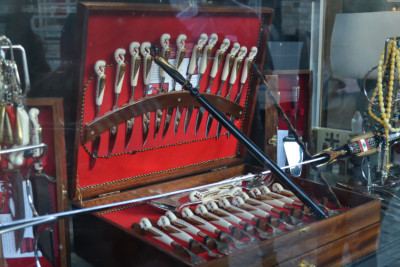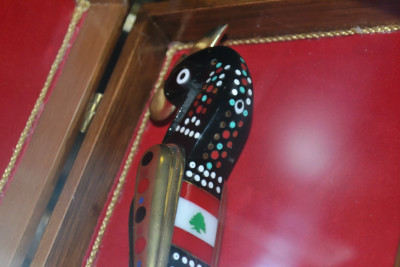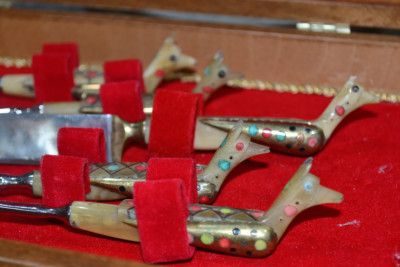Jezzine’s cutlery
 Jezzine’s craft tradition dates back to the 1770s, when the Haddad family settled in the village. First of all, it was a family job. Craftsmen first made swords, daggers and guns from buffalo horn and bone, but in the 1930s the family specialized in cutlery and tableware.
Jezzine’s craft tradition dates back to the 1770s, when the Haddad family settled in the village. First of all, it was a family job. Craftsmen first made swords, daggers and guns from buffalo horn and bone, but in the 1930s the family specialized in cutlery and tableware.
 The peculiarity of Jezzine’s cutlery is characterized not only by the quality of the blades, but also by the handles. The handle is shaped like the head of a phoenix, a legendary bird in Phoenician mythology – a firebird from paradise – lives 500 years, filling the air with its heavenly voice before perishing in fire. It then rises from the ashes to live another 500 years. Rising from its ashes, this mythical bird evokes Lebanon, a country constantly recovering from war and crisis. The sculptures of the bird are symbolic, the decoration changes over time but this bird remains invariable. It is said that the ancestor of the family was installed under a tree when a bird landed near him. He then began to carve it out of a piece of wood. This is how the tradition was born and passed down from generation to generation until today. This handle was made of ivory, sheep, buffalo and goat horns which are carved into the firebird’s head and body, polished and fitted with stainless steel utensils. Brass wings are added, and hand-painted details. Black and ivory are the traditional colors, reflecting the color of the base material. Nowadays, it is made with bone powder that is mixed with cellulose acetate and poured into molds, rather than horn. New colors, different styles of head crests, beaks and wings were introduced on the handle. Some pieces are encrusted with brass and copper, others with mother of pearl. The phoenix itself does not change because it’s the tradition.
The peculiarity of Jezzine’s cutlery is characterized not only by the quality of the blades, but also by the handles. The handle is shaped like the head of a phoenix, a legendary bird in Phoenician mythology – a firebird from paradise – lives 500 years, filling the air with its heavenly voice before perishing in fire. It then rises from the ashes to live another 500 years. Rising from its ashes, this mythical bird evokes Lebanon, a country constantly recovering from war and crisis. The sculptures of the bird are symbolic, the decoration changes over time but this bird remains invariable. It is said that the ancestor of the family was installed under a tree when a bird landed near him. He then began to carve it out of a piece of wood. This is how the tradition was born and passed down from generation to generation until today. This handle was made of ivory, sheep, buffalo and goat horns which are carved into the firebird’s head and body, polished and fitted with stainless steel utensils. Brass wings are added, and hand-painted details. Black and ivory are the traditional colors, reflecting the color of the base material. Nowadays, it is made with bone powder that is mixed with cellulose acetate and poured into molds, rather than horn. New colors, different styles of head crests, beaks and wings were introduced on the handle. Some pieces are encrusted with brass and copper, others with mother of pearl. The phoenix itself does not change because it’s the tradition.
 This art has entered into the history of the country and has crossed its borders, bringing the Lebanese authorities prestigious gifts to offer to heads of state or their guests. The craft developed so much in Jezzine that several families started making cutlery of the same name in their hometown. In the 1950s and 1960s, some 35 workshops employed more than 150 people. The craftsmanship was so important that from the 1960s to the 1980s artisans traveled to fairs in Europe to show their products.Today, the Jezzine Crafts Cooperative, oversees 11 cutlery workshops in the village and there are very few people from the new generations to learn and pursue this profession.
This art has entered into the history of the country and has crossed its borders, bringing the Lebanese authorities prestigious gifts to offer to heads of state or their guests. The craft developed so much in Jezzine that several families started making cutlery of the same name in their hometown. In the 1950s and 1960s, some 35 workshops employed more than 150 people. The craftsmanship was so important that from the 1960s to the 1980s artisans traveled to fairs in Europe to show their products.Today, the Jezzine Crafts Cooperative, oversees 11 cutlery workshops in the village and there are very few people from the new generations to learn and pursue this profession.

